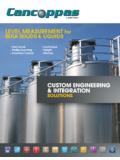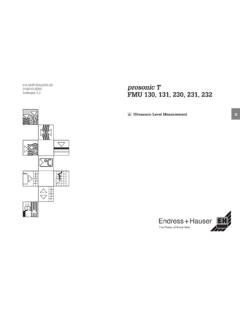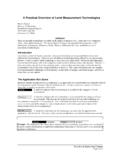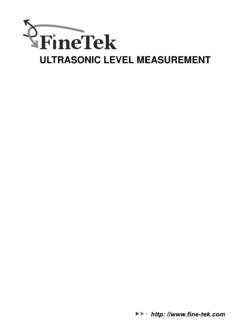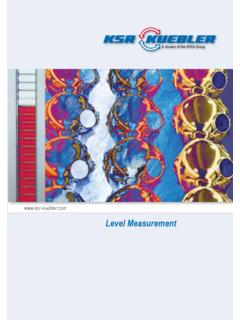Transcription of FLOW & LEVEL LEVEL MEASUREMENT FOR OVERFILL …
1 & LEVEL12 November 2017 Control Engineering EuropeLEVEL MEASUREMENT FOR OVERFILL prevention APPLICATIONST here is no one size fi ts all LEVEL MEASUREMENT technology for overfi ll prevention systems, says Christoffer OVERFILL prevention System (OPS)Basic Process Control System (BPCS)LTLTLCE mergency response layerPassive protection layerSafety layerBasic process control systemMitigationPreventionFire brigadeSecondary containment ( dike)DCS and tank gauging system/inventory softwareMinimising the risk of overfi lls involves many independent protection overfi lling of tanks and vessels is a leading cause of serious incidents in the process and bulk liquid storage industries, especially as the materials involved are often hazardous, fl ammable and even companies storing hazardous materials, investment in a robust Overfi ll prevention System (OPS), complying with current safety standards, is essential. IEC 61511 provides best safety practices for the implementation of a modern OPS within the process industry.
2 Additionally, API 2350 provides minimum requirements to comply with modern best practices in the specifi c application of non-pressurised above-ground large petroleum storage the risk of overfi lls involves many independent protection layers. The primary layer is the Basic Process Control System (BPCS), which monitors and controls the production processes. A correctly functioning BPCS will prevent the need for the other layers to become active. The second layer of protection is the safety layer (typically denoted as an OPS), which must remain separate and independent of the BPCS to provide redundancy. This should prevent an overfi ll from occurring if there is a failure or problem with the BPCS. The next layer is the passive protection layer, which provides secondary containment such as dikes or concrete walls. Finally, there is the emergency response layer, which involves alerting the emergency are two basic types of OPS Manual Overfi ll prevention Systems (MOPS) and Automatic Overfi ll prevention Systems (AOPS).
3 MOPS are seen to be easier to implement and less complex, with lower initial costs. They typically consist of a LEVEL sensor or switch that transmits an audio-visual alarm to an operator, notifying them to take appropriate actions such as manually opening or shutting off a valve to prevent an overfi ll. AOPS include the ability to achieve higher risk reduction factors, shorter response times, and a reduced workload for operators. They typically consist of a LEVEL sensor, a logic solver and a fi nal control element in the form of actuated valve overfi ll prevention solutions, there is no one size fi ts all LEVEL MEASUREMENT technology and system. Different applications have their own challenges and requirements, so it is important to select the appropriate technologies for each. These include:Electro-mechanical fl oat and displacer switches: Used for point LEVEL , interface, and density applications , where the buoyancy of the displacer in the fl uids is the primary MEASUREMENT principle.
4 Displacers have moving parts that require frequent cleaning and replacement. They are affected by mechanical vibration and turbulence, the mechanical parts can give false readings, and maintenance costs can be high. Displacers are increasingly being replaced by modern electronic technologies that offer greater diagnostics and reliability, and lower lifecycle fork switches: A point LEVEL technology which operates using the concept of a tuning fork. Two prongs are immersed into the process vessel and an internal piezo-electric crystal oscillates them at their natural frequency. This frequency varies as the fork is immersed in the medium. Any changes are detected by the electronics, providing an effective means of detecting the presence or absence of liquids. With no moving parts to wear or stick, vibrating fork technology is less prone to failure than other technologies. Operation is virtually unaffected by fl ow, turbulence, bubbles, foam, vibration and changing wave radar: Low energy microwave pulses are guided down a probe, which is submerged into the process media.
5 When the microwaves are refl ected from the product surface to the transmitter, the LEVEL can be measured. Because a proportion of the emitted pulse continues down the probe, an interface can also be detected. Guided wave radar transmitters are easy to install, and no compensation FLOW & 2017 Control Engineering Europeis necessary for changes in density, dielectric or conductivity of the medium. Changes in pressure, temperature and most vapour space conditions have no impact on MEASUREMENT accuracy. The technology is unaffected by high turbulence or vibrations, and build-up has practically no effect, meaning that there is no need for recalibration. With no moving parts, maintenance requirements are radar: Non-contacting radar gauges use pulse radar or Frequency Modulated Continuous Wave (FMCW) techniques. Microwaves are emitted towards the surface and reflected to the sensor, with the LEVEL being directly proportional to the time taken between transmission and reception of the microwave signal.
6 With FMCW, the radar transmits a continuous signal sweep with a constantly changing frequency. The frequency of the reflected signal is compared with the frequency of the signal transmitted at that moment. The difference between these frequencies is proportional to the distance from the radar to the surface, thus the LEVEL is measured. This technology is unaffected by density, viscosity, and conductivity, and little affected by coating and vapours. It is easy to install and commission, and as there is no contact with the medium and the radar has no moving parts, little maintenance is technology: Non-contacting radar LEVEL gauges featuring 2-in-1 technology can be used simultaneously in both a BPCS and an OPS. This technology is used in Emerson s Rosemount 5900S 2-in-1 radar LEVEL gauge, which consists of two separate and independent electrical units and a common antenna. This solution allows for cost-efficient safety upgrades of existing tanks by replacing a single BPCS or AOPS sensor with two continuous LEVEL measurements, with little or no tank typesThere are three general application types in the process and bulk liquid storage industries where OVERFILL prevention measures are employed.
7 These are process vessels and storage tanks within process applications , and storage tanks deployed within the bulk liquid handling industry. Each presents different challenges, so the most appropriate OVERFILL protection technology differs vessels: The choice of technology to use as part of the AOPS depends on the vessel s shape, size and design. For example, on cone-shaped tanks LEVEL sensors are top-mounted, which creates several options, including guided wave radar transmitters, non-contacting radar gauges and vibrating fork switches. Many vessels have restrictions including agitators, heat exchangers and other internal structures that require the use of a separate chamber to perform the LEVEL MEASUREMENT . For these applications guided wave radar transmitters are recommended. Should a side-mounted solution be required, vibrating fork switches provide the ideal distillation columns, involving high temperatures where vapours rise through the column, different components will condense at different temperatures and accumulate for withdrawal.
8 Here chambers are required, and guided wave radar transmitters are commonly used for the AOPS. Blending tanks have agitators, which place restrictions on sensors that protrude into the tank. Using a top-mounted, non-contacting radar is usually a good solution for an AOPS sensor. Sloshing, rapid LEVEL changes, vortices and foaming are common in this application, making it important to select a modern and highly capable radar device. In boiler drum applications , SIL 3 guided wave radar transmitters which are unaffected by changes in process conditions are required for AOPS, usually with triple monitoring system: Tank monitoring system applications include those consisting of multiple small or medium-sized vessels or a smaller tank farm, typically 5-20 tanks, requiring an automated system to provide LEVEL monitoring, but not necessarily control. These systems ease the workload by removing manual measurements, and increase personnel safety by reducing the need to climb tanks. Tank monitoring would typically involve gross volume calculations, but not fiscal measurements.
9 For these applications , the recommendations for OVERFILL sensors are like those provided for single vessel applications . Correct sensor choice would therefore be determined by the tank type, the available openings, and the liquids stored liquid storage: In bulk liquid storage applications , an Automatic Tank Gauging system (ATG) is typically used as the BPCS, to measure LEVEL and calculate inventory. These systems deploy radar technology offering exceptional levels of accuracy, which is required due to the value of liquid being measured. A small inaccuracy of the LEVEL can equate to thousands of gallons of volume uncertainty. The AOPS for bulk liquid storage tanks typically consists of a non-contacting radar gauge, a logic solver and an actuator. Alternatives would be to use a vibrating fork switch or a guided wave radar transmitter. Many bulk storage tanks have floating roofs, which place special demands on the LEVEL MEASUREMENT and OVERFILL prevention solution. Best practice is to measure through a still pipe, which requires high precision, non-contacting radar for accuracy.
10 If the tanks do not have a still pipe, an option is to shoot the roof , which entails putting a reflective metal target on top of the roof to capture the radar OVERFILL prevention systems can reduce risk and ensure safety compliance, but with no one size fits all LEVEL MEASUREMENT technology, understanding the application and its specific challenges is crucial. Christoffer Widahl is a senior strategic product manager with Emerson, based in Gothenburg, Sweden.










